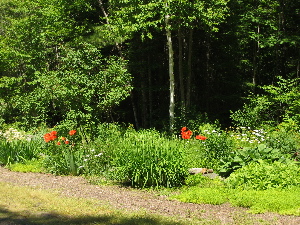Ben Kilham on "Bears"!
Here's an article written for a local paper. I have left out all the stuff about the local happenings, but kept the part about Ben Kilham and his observations about BEARS. I think you'll find it interesting. If you'd like to read the entire article it can be found here.
"Carroll County Independent
© 2005
AUGUST 11, 2005
Kilham shares bear experiences
By TERRY LEAVITT
Editor
FREEDOM -- They say the child is the father of the man.
Ben Kilham has tried to bring that perspective to his studies of the behavior of bears.
What he has found are intelligent animals, shaped in great part by learning, rather than just instinct. He also found bears to be social creatures that study other animals' behavior, including humans' as they make decisions on how to interact with them.
Kilham, author of "Among the Bears," was in Freedom Saturday night to talk about his work rehabilitating bear cubs and studying bear behavior."
...
"For the past 12 years, Kilham has been working with bears in Lyme.
Kilham's hoped for career as a naturalist was initially sidetracked because he could not get into graduate school. He graduated from University of New Hampshire in 1974 with a degree in wildlife, but said because he is dyslexic, his grades were below par and he was not accepted into a graduate program.
He learned a trade, becoming a gunsmith, and returned to New Hampshire in the 1980s.
"I thought I could do something on the side, documenting juvenile behavior in animals," he said. "I thought that by studying juvenile animals that was the way to learn about behavior."
The son of virologist Lawrence Kilham, who also studied birds in a second career, Ben Kilham said he learned much from his father about studying nature.
"My dad's work was very similar," he said, adding that his father advised him, "Don't worry about discovering something new. It's really very exciting to learn something for yourself."
What does it take to be a good bear observer? Patience. Kilham said he has found that hunters are among the best observers because they know how to sit and wait and watch.
His work has been criticized by some scientists for not following modern scientific methods.
Kilham said he owes more to the methods of 19th century naturalists than most people working in academic research today. In graduate school these days, he said, most people learn to read books and then design experiments.
"They've gotten away from the true naturalists. They're just not observers. What I'm doing is not playing by their rules and I'm learning a lot of stuff," he said.
But with endorsements from such leaders in the field as noted biologist George Schaller, Kilham's work has gained more respect.
"They're beginning to realize I know more about bear behavior than anyone else in the world," he said.
Discovering what everybody knows
Kilham had not planned to study bears, but the animals he chose turned out to be scarce. Then Fish and Game officers brought him two orphaned black bear cubs and asked him to raise them. He got a license from the state and began rehabilitating bears in 1993. Since then he has raised about 45 black bear cubs, some of which he has followed into adulthood.
"The secret of studying black bear behavior is to be around them all the time," he said.
When he started, Kilham was no expert.
"What I knew is probably what you know -- what I'd heard," he said. But, he said, he expected that bear behavior was well documented and most of what there was to be known had been discovered. He began reading and found that wasn't the case.
Little had been written about bear behavior, other than on the subject of aggression, and that was not well understood. He found there were things to learn about bear biology as well.
Kilham identified a behavior he calls mouthing, by which bears will take plants and hold them in their mouths, and determine from that whether they are good to eat. At the end of a season, he found that there were 125 new plants that his cubs were eating and many more they were rejecting. From this, he went on to identify an undiscovered organ in the bears' nasal cavity that help them identify scents.
He also learned that he could teach the bears what to eat.
"I discovered this as I discovered most things, by accident," he said.
One day he tried eating red clover, which he knew both he and the bears could safely eat, and he found that they immediately tried the clover. He learned that they trusted him, would learn by imitation and displayed the mouthing behavior to recognize the food.
Kilham's first set of bear cubs provided a steep learning curve for him as well as the cubs.
Bears instinctively know how to climb trees, he said, and are extraordinary climbers. One day while walking in the woods with the cubs, they were spooked by a moose and scampered up a 90-foot maple tree.
Kilham had read that when bears had been observed in this situation, after the danger had passed the mother bear made grunts and groans and the cubs came down the tree. "So I made some grunts and groans," he said, "and the cubs stayed up in the tree." How did he get them down again? Eventually, he just said, "Hey guys, come on, let's go," and down they came.
He noticed early on that bear cubs show signs of self-awareness and self-concealment. People don't often see black bears, he said because the bears see them first.
"Black bears may hide behind a log or boulder and let you walk by," he said.
Instinctively cubs will follow their mother, so Kilham found that in his role as surrogate parent he could take the bears on long walks in the woods and return them to their cages at night.
He learned that they eat scat to ingest the bacteria to help them digest cellulose.
He found that adult bears will teach young bears about denning, through active demonstration. "This is indicative of high intelligence only documented in chimpanzees," he said.
The observer observed
He learned about social interactions among bears, as well as what bears do when they meet humans. The first time Kilham encountered a wild adult female bear, while he was looking for a cub, the bear initially charged at him several times, and after he stood his ground in a non-threatening way the bear backed off and waited.
"At the end of an hour I realized this bear was doing the same thing as I was doing to her, observing us. They can watch and read your behavior better than you can read behavior," he said.
"Bears communicate in a way very similar to our emotional communication," he said. Expressions and inflections in our words give much more information than people generally realize.
Kilham said that if a person encounters bear in the wild, the best way to react is to keep an eye on the bear, stand erect, don't leave, and talk softly to the bear. You want to show the bear that you are not a weakling, but also not a threat, he said. "Bears have a social makeup based on dominance," he said. "The only bear you've got to worry about is a bear that won't run from you." That usually means coming between a sow and her cubs.
"Most of the injuries that occur are because people have behaved badly, and done something to threaten. What you want to be doing is playing down the situation. This is good advice with every animal, including humans."
But in some ways, people treat bears a little too much as if they were humans, he said. They become angry when bears destroy bird feeders, when for the bears it is just a good source of food. "Bears tend to prioritize food by quality, quantity and amount of risk involved," he said. "They're not greedy. They're just maximizing their feeding opportunities."





2 Comments:
We could use someone like this gentleman here in NJ. People are moving into bear habitat in large numbers so the number of encounters is growing. Instead of trying to understand bears and their behavior, everyone acts as if they (the bears) are dangerous intruders and should be gotten rid of. We even have an annual debate about a bear hunt. I just don't understand why no one sees that we are the dangerous intruders, not the bears.
Sorry, I'll get off my soapbox. Thanks for the wonderful article.
This comment has been removed by a blog administrator.
Post a Comment
<< Home